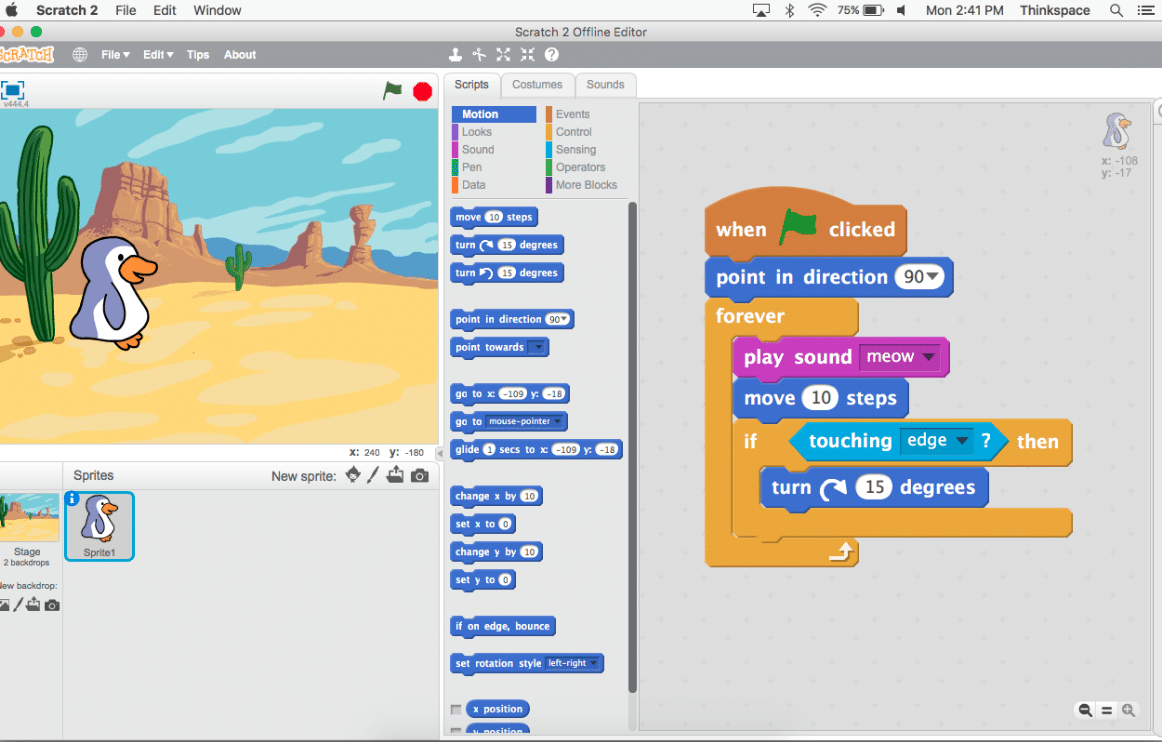Programación visual y gamificación. Análisis de Doodle

La entrada de hoy no iba a ser esta, pero visitando el Doodle de hoy 04/12/2017 en el que se celebra el 50 aniversario de códigos de programación para niños, he visto que es un buen día para hablar sobre ese tema.
Así que hoy hablaré sobre herramientas de programación visual sencillas, que nos ayudan a aproximarnos a la programación, o al menos a la forma de afrontar los problemas que suele encontrar un programador. Todo esto con herramientas sencillas, muy visuales y en muchas ocasiones gamificadas.
Hoy no entraré en profundidad en cada una de ellas, lo cual lo relego a futuras entradas, ya que el tema creo que da para varias de ellas, simplemente haré un breve paseo por varias herramientas que siguen esta estructura, centrándome en la propuesta por Google.

Cómo no vamos a ayudar a tan entrañable conejo.
Comenzaré con lo primero que he comentado, el Doodle que ha presentado hoy Google. Con una estética flat en isométrico, es un juego que te enseña los fundamentos de programación. El juego no es original, ya había conocido versiones como el lightbot, pero eso no le resta valor, ya que esta versión cuenta con ciertos toques de gamificación que me han gustado mucho, además del alcance que logra Google con cualquier acción lo cual siempre es reseñable y nos brinda la oportunidad de hablar sobre este tema.
El juego simplemente trata de que un conejo vaya por un camino recogiendo las zanahorias que tiene por el mismo, hasta obtnerlas todas. La forma en la que se logra esto es dándole una serie de acciones como avanzar, cambios de dirección, bucles que puedes aplicar para que no tengas que repetir una secuencia hasta el aburrimiento fomentando así usar un “código” más limpio, etc.

Puedes insertar bucles para no hacer tan tedioso el proceso.
El programa te va premiando si efectivamente das respuestas con una estructura más limpia, mediante un sistema de progreso y logros.
El tutorial que tiene es digno de mención ya que se tratan de perlas de información que aparecen antes de cada nuevo puzle, donde, en el mismo puedes probar los nuevos comandos que van introduciendo en el juego. Lo pruebas, cumples con el tutorial e inmediatamente puedes resolver el siguiente puzle incorporando el nuevo comando. Así de sencillo y así de eficaz, una herramienta que se me antoja ideal si buscamos que nuestros pequeños (y no tan pequeños) se aproximen a los fundamentos de la programación.

El tutorial es un ejemplo de lo que debería ser cualquier tutorial. Perlas de información útiles para el usuario.
Esto es algo que están teniendo cada vez más en cuenta en las aulas donde la gamificación está entrando con fuerza. Nos encontramos además más optativas de programación y robótica para los alumnos y es en esos casos donde herramientas como estas se antojan muy útiles.
No puedo dejar pasar la oportunidad de mencionar una herramienta que se está usando bastante y que se basa en la misma idea de programación visual. Esta herramienta es Scratch, que es un paso más allá del juego que hemos comentado. Con Scratch ya podemos programar un juego o herramienta que nosotros necesitamos, utilizando el mismo sistema de paquetes visuales y una forma de estructurarlos similar. Pero en este caso el programa es bastante más complejo y completo ya que definimos el entorno, los objetos, sus propiedades, etc. Se puede utilizar para diferentes proyectos que se tengan. Se puede hacer un juego como la serpiente que coje manzanas, alguna aventura interactiva click and point básica, presentaciones… La capacidad de soluciones es tan amplia porque nos encontramos con un lenguaje de programación que ya no queda encorsetado en las soluciones a un juego.

Scratch permite hacer tus pequeños programas, presentaciones o juegos
Scratch es una herramienta que muchos profesores están empezando a incorporar en las aulas y en muchos centros lo están usando como herramienta de aproximación a la programación por parte de los alumnos.
En futuras entradas analizaré con más profundidad scratch y otros herramientas y juegos de programación.
———————–
Visual programming and gamification. Doodle Review 04/12/2017
Today’s entry was not going to be this one, but visiting the Doodle of today’s 04/12/2017 which is celebrating the 50th anniversary of kids’ programming languages, I have seen that it is a good day to talk about that topic.
So today I will talk about simple visual programming tools that help us approach programming, or at least how to deal with the problems that a programmer usually faces. All of this with simple tools, very visual and often gamified.
Today I won’t go into each one of them in depth, which I’m relegating to future entries, because this topic gives me for several entries, I’ll just take a brief walk through the tools that follow this structure, focusing on the Google proposal.

How can we not help such a lovely rabbit.
I’ll start with the first thing I mentioned, the Doodle that Google presented today. With an isometric flat aesthetics, it’s a game that teaches you the basics of programming. The game is not original, I’ve already known versions like lightbot, but it doesn’t detract from that value, since this version has certain elements of gamification that I like very much, in addition to the range that Google achieves with any action which is always remarkable and gives us the opportunity to talk about this subject.
The game simply tries to get a rabbit to follow a path by picking up the carrots that it has in it, until it gets them all. The way in which this is achieved is by giving it a series of actions such as advancing, changes of direction, loops that you can apply to avoid having to repeat a sequence until boredom, thus encouraging you to use a cleaner «code».

You can insert loops to make the process less tedious.
The program rewards you if you effectively give answers with a cleaner structure, through a system of progress and achievements.
The tutorial it has is worthy of mention since they have pieces of information that appear before each new puzzle, where, in it you can try the new commands that are introduced in the game. You try it, comply with the tutorial and immediately you can solve the following puzzle by adding the new command. As simple and effective as that, a tool that I find ideal if we look for our children (and not so children) to approach the fundamentals of programming.

The tutorial is an example of what any tutorial should look like. Pieces of useful information for the user.
This is something that they are increasingly taking into account in the classroom where gamification is entering strongly. There are also more optional subjects about programming and robotics for students and it is in those cases where tools like these are very useful.
I can not miss the opportunity to mention a tool that is being used a lot and that is based on the same idea of visual programming. This tool is Scratch, which is a step beyond the game we’ve discussed. With Scratch we can already program a game or a tool that we need, using the same visual packages system and a similar way to structure them. But in this case the program is much more complex and complete because we can use it to define the environment, the objects, their properties, etc. It can be used for different projects that you have. You can make a game like the snake that picks up apples, some basic interactive adventure click and point, presentations… The range of solutions is so wide because we find a programming language that is no longer embedded in the solutions to a game.

Scratch lets you make your small programs, presentations or games
Scratch is a tool that many teachers are starting to incorporate into the classroom and in many schools are using as a tool to approach programming for students.
In future entries I will analyze scratch and other programming tools and games in greater depth.



